

Jack The Ripper
In Victorian England during the late 19th Century there were a string of murders that were committed by person or persons unknown. Today, over 120 years later the murders still capture the imagination of professional and amateur sleuths alike.
The Victims
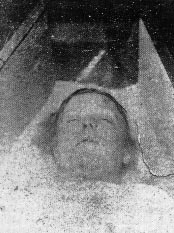 MARY ANNE NICHOLS
(1845-88)
MARY ANNE NICHOLS
(1845-88)
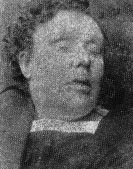 ANNIE CHAPMAN
(1841-88)
ANNIE CHAPMAN
(1841-88)
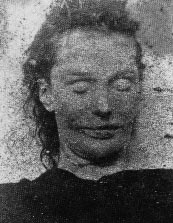 ELIZABETH STRIDE
(1843-88)
ELIZABETH STRIDE
(1843-88)
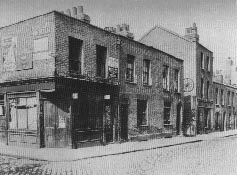 September at 1.00 am when Louis Diemschutz turned his pony and trap into the
yard behind 40 Berner Street. Her throat had been cut so recently, it was felt
that Louis' untimely arrival had probably disturbed the Ripper during the
attack.
September at 1.00 am when Louis Diemschutz turned his pony and trap into the
yard behind 40 Berner Street. Her throat had been cut so recently, it was felt
that Louis' untimely arrival had probably disturbed the Ripper during the
attack.
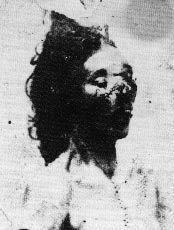 CATHERINE EDDOWES
(1842-88)
CATHERINE EDDOWES
(1842-88)
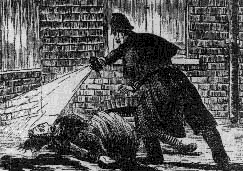 night as Elizabeth Stride. After the Ripper had been
disturbed he went on to search for another victim. Catherine had been
slaughtered like the others, her intestines strewn from her body. The killer
was indeed busy tonight, the chalked message appeared on a wall in Goulston
Street next to a bloodied piece of Kate Eddowes apron. The message read:
night as Elizabeth Stride. After the Ripper had been
disturbed he went on to search for another victim. Catherine had been
slaughtered like the others, her intestines strewn from her body. The killer
was indeed busy tonight, the chalked message appeared on a wall in Goulston
Street next to a bloodied piece of Kate Eddowes apron. The message read:
"The Juwes are the men That Will not be Blamed for nothing"
The exact meaning behind this message is lost forever.
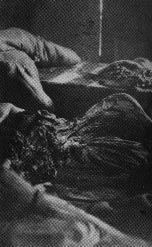 MARY KELLY (1863-88)
MARY KELLY (1863-88)
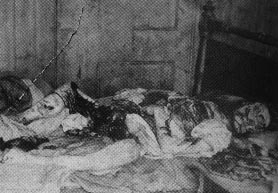 have better served the prestigious West End clients as opposed to working the
grim streets of the East End. Mary was born in Limerick, Ireland and moved to
Wales where she married a collier who was tragically killed in a pit disaster.
After turning to prostitution in Cardiff, she moved south to London where she
worked in a West End brothel. "Fair Emma" came to lodge at various
abodes around Dorset Street, London, the "Wicked Quarter Mile", and
it was at Millers Court that she was found brutally murdered. She was buried
at Walthamstow R.C. cemetery on 19th November
have better served the prestigious West End clients as opposed to working the
grim streets of the East End. Mary was born in Limerick, Ireland and moved to
Wales where she married a collier who was tragically killed in a pit disaster.
After turning to prostitution in Cardiff, she moved south to London where she
worked in a West End brothel. "Fair Emma" came to lodge at various
abodes around Dorset Street, London, the "Wicked Quarter Mile", and
it was at Millers Court that she was found brutally murdered. She was buried
at Walthamstow R.C. cemetery on 19th November
Dr Thomas Bond's (Police Surgeon to A Division) report on Mary Jane Kelly
Position of the body:
The body was lying naked in the middle of the bed, the shoulders flat, but the axis of the body inclined to the left side of the bed. The head was turned on the left cheek. The left arm was close to the body with the forearm flexed at a right angle & lying across the abdomen. The right arm was slightly abducted from the body and rested on the mattress, the elbow bent & the forearm supine with the fingers clenched. The legs were wide apart, the left thigh at right angles tot he trunk and the right forming an obtuse angle with the pubes.
The whole of the surface of the abdomen and thighs was removed and the abdominal Cavity (sic) emptied of it's viscera. The breasts were cut off, the arms mutilated by several jagged wounds and the face hacked beyond recognition of the features. The tissues of the neck were severed all round down to the bone.
The viscera were found in various parts viz: the uterus and Kidneys with one breast under the head, the other breast by the Rt foot, the Liver between the feet, the intestines by the right side and the spleen by the left side of the body. The flaps removed from the abdomen and thighs where on a table.
The bed clothing at the right corner was saturated with blood, and on the floor beneath was a pool of blood covering about 2 feet square. The wall by the right side of the bed and in a line with the neck was marked by blood which had stuck in a number of separate splashes.
Post Mortem Examination
The face was gashed in all directions the nose, cheeks, eyebrows and ears being partly removed. The lips were blanched and cut by several incisions running obliquely down to the chin. There were also numerous cuts extending irregularly across all the features.
The neck was cut through the skin and other tissues right down to the vertebrae the 5th and 6th being deeply notched. The skin cuts in the front of the neck showed distinct ecchymosis (blood pooling under the skin - like severe bruising).
The air passage was cut at the lower part of the larynx through the circoid cartilage.
Both breasts were removed by more or less circular incisions, the muscles down to the ribs being attached to the breasts. The intercostals between the 4th, 5th and 6th ribs were cut through and the contents of the thorax visible through the openings.
The skin and tissues of the abdomen from the costal arch to the pubes were removed in three large flaps. The right thigh was denuded in front to the bone, the flap of skin, including the external organs of generation and part of the right buttock. The left thigh was stripped of skin, fascia and muscles as far as the knee.
The left calf showed a long gash through skin and tissues to the deep muscles and reaching from the knee to 5 in above the ankle.
Both arms and forearms had extensive and jagged wounds.
The right thumb showed a small superficial incision about 1 in long, with extravastion of blood in the skin and there were several abrasions on the back of the hand moreover showing the same condition.
On opening the thorax it was found that the right lung was minimally adherant by old firm adhesions. The lower part of the lung was broken and torn away.
The left lung was intact: it was adherant at the apex and there were a few adhesions over the side. In the substances of the lung were several nodules of consolidation.
Unrelated Victims
Suspects
The suspects over the years has become an incredibly long list from the future king of England to a serial killer incarcerated in America.
According to the Metropolitan police files there are only four suspects " with a genuine claim having been nominated by contemporary police officers" (Metro Police Crime Museum)
Kosminski was certainly favoured by the head of the C.I.D. Dr. Robert Anderson, and the officer in charge of the case, Chief Inspector Donald Swanson. Druitt appears to have been Macnaghten's preferred candidate, whilst the fact that Ostrog was arrested and incarcerated before the report was compiled leaves the historian puzzling why he was included as a viable suspect in the first place.
The fourth suspect, Tumblety, was stated to have been "amongst the suspects" at the time of the murders and "to my mind a very likely one," by the ex-head of the Special Branch at Scotland Yard in 1888, ex-Detective Chief lspector John George Littlechild. He confided his thoughts in a letter dated 23 September, 1913, to the criminological journalist and author George R Sims.
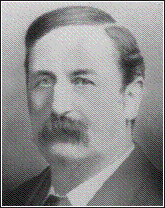 For
a list of viable suspects they have not inspired any uniform confidence in the
minds of those well-versed in the case.
For
a list of viable suspects they have not inspired any uniform confidence in the
minds of those well-versed in the case.
Indeed, arguments can be made against all of them being the culprit, and no hard evidence exists against any of them. What is obvious is the fact that the police were at no stage in a position to prove a case against anyone, and it is highly unlikely a positive case will ever be proved. If the police were in this position in 1888-1891, then what hope for the enthusiastic modern investigator?
To clear the confusion for the new student of the case we have to return to factual basics. Just who was 'Jack the Ripper,' and what were the 'Whitechapel murders'?
Other Players
The Letters
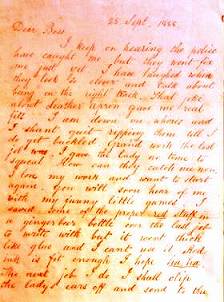
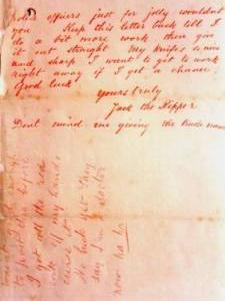
Dear Boss,
I keep on hearing the police have caught me but they wont fix me just yet. I
have laughed when they look so clever and talk about being on the right
track. That joke about Leather Apron gave me real fits. I am down on whores and
I shant quit ripping them till I do get buckled. Grand work the last job was. I
gave the lady no time to squeal. How can they catch me now. I love my work and
want to start again. You will soon hear of me with my funny little games. I
saved some of the proper red stuff in a ginger beer bottle over the last
job to write with but it went thick like glue and I cant use it. Red ink is fit
enough I hope ha. ha. The next job I do I shall clip the ladys ears off
and send to the police officers just for jolly wouldn't you. Keep this letter
back till I do a bit more work, then give it out straight. My knife's so nice
and sharp I want to get to work right away if I get a chance. Good Luck.
Yours truly
Jack the Ripper
Dont mind me giving the trade name
PS Wasnt good enough to post this before I got all the red ink off my hands curse it No luck yet. They say I'm a doctor now. ha ha
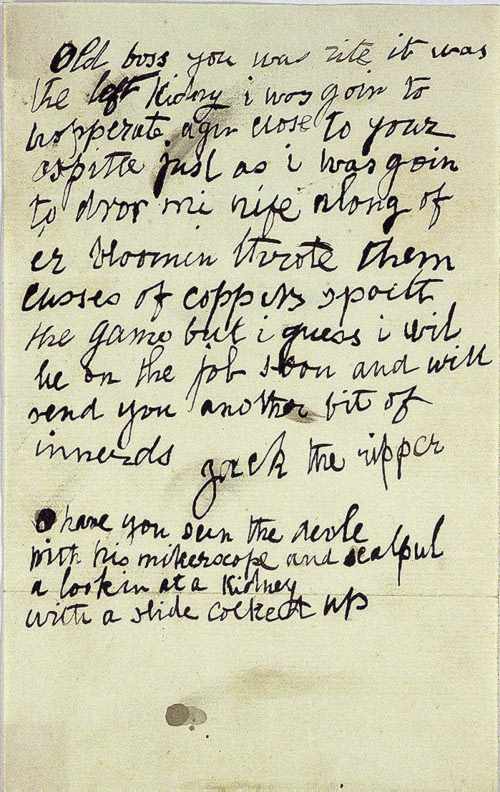
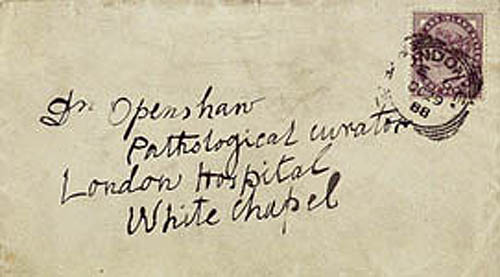
Dated 29 October 1888
Old boss you was rite it was the left kidny I was goin to hopperate agin close to you ospitle just as I was going to dror mi nife along of er bloomin throte cusses of coppers spoilt the game but I guess I will be on the job soon and will send you another bot of innerds
Jack the Ripper.
O have you seen the devlle with his mikerscope and scalpol a lookin at a Kidney with a skide cocked up.
Bibliography:
Metropolitan Police Service Crime Museum Archives
Jack the Ripper A to Z by Paul Begg, Martin Fido, and Keith Skinner published by Headline, 1996
The Complete History of Jack the Ripper, by Philip Sugden, published by Robinson, 1995